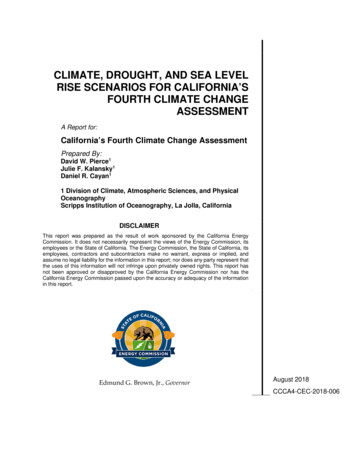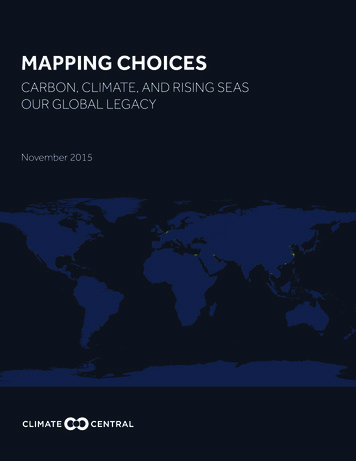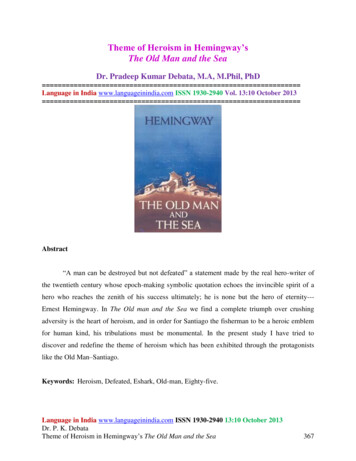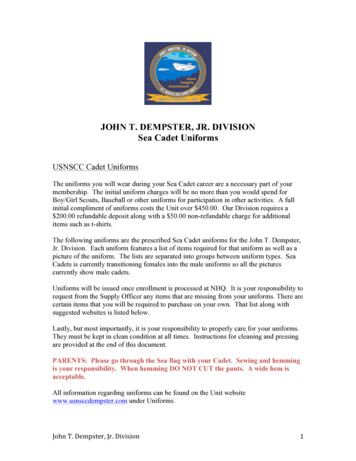
Transcription
CLIMATE, DROUGHT, AND SEA LEVELRISE SCENARIOS FOR CALIFORNIA’SFOURTH CLIMATE CHANGEASSESSMENTA Report for:California’s Fourth Climate Change AssessmentPrepared By:David W. Pierce1Julie F. Kalansky1Daniel R. Cayan11 Division of Climate, Atmospheric Sciences, and PhysicalOceanographyScripps Institution of Oceanography, La Jolla, CaliforniaDISCLAIMERThis report was prepared as the result of work sponsored by the California EnergyCommission. It does not necessarily represent the views of the Energy Commission, itsemployees or the State of California. The Energy Commission, the State of California, itsemployees, contractors and subcontractors make no warrant, express or implied, andassume no legal liability for the information in this report; nor does any party represent thatthe uses of this information will not infringe upon privately owned rights. This report hasnot been approved or disapproved by the California Energy Commission nor has theCalifornia Energy Commission passed upon the accuracy or adequacy of the informationin this report.Edmund G. Brown, Jr., GovernorAugust 2018CCCA4-CEC-2018-006
ACKNOWLEDGEMENTSWe acknowledge the World Climate Research Programme's Working Group on CoupledModelling, which is responsible for the Climate Model Intercomparison Project (CMIP), and wethank the climate modeling groups for producing and making available their model output. ForCMIP the U.S. Department of Energy's Program for Climate Model Diagnosis andIntercomparison provides coordinating support and led development of software infrastructurein partnership with the Global Organization for Earth System Science Portals.This work was supported by the California Energy Commission, Agreement Number 500-14-005.Additional support was obtained from the U.S. Army Corps of Engineers, from the U.S.Department of Interior/U.S. Geological Survey via the Southwest Climate Science Center, andfrom the National Oceanographic and Atmospheric Administration Regional Integrated Sciencesand Assessments (RISA) Program through the California Nevada Applications Program RISA.i
PREFACECalifornia’s Climate Change Assessments provide a scientific foundation for understandingclimate-related vulnerability at the local scale and informing resilience actions. These assessmentscontribute to the advancement of science-based policies, plans, and programs to promote effectiveclimate leadership in California. In 2006, California released its First Climate Change Assessment,which shed light on the impacts of climate change on specific sectors in California and wasinstrumental in supporting the passage of the landmark legislation Assembly Bill 32 (Núñez,Chapter 488, Statutes of 2006), California’s Global Warming Solutions Act. The SecondAssessment concluded that adaptation is a crucial complement to reducing greenhouse gasemissions (2009), given that some changes to the climate are ongoing and inevitable, motivatingand informing California’s first Climate Adaptation Strategy released the same year. In 2012,California’s Third Climate Change Assessment made substantial progress in projecting localimpacts of climate change, investigating consequences to human and natural systems, andexploring barriers to adaptation.Under the leadership of Governor Edmund G. Brown, Jr., a trio of state agencies jointly managedand supported California’s Fourth Climate Change Assessment: California’s Natural ResourcesAgency (CNRA), the Governor’s Office of Planning and Research (OPR), and the CaliforniaEnergy Commission (Energy Commission). The Climate Action Team Research Working Group,through which more than 20 state agencies coordinate climate-related research, served as thesteering committee, providing input for a multi-sector call for proposals, participating in selectionof research teams, and offering technical guidance throughout the process.California’s Fourth Climate Change Assessment (Fourth Assessment) advances actionable sciencethat serves the growing needs of state and local-level decision-makers from a variety of sectors. Itincludes research to develop rigorous, comprehensive climate change scenarios at a scale suitablefor illuminating regional vulnerabilities and localized adaptation strategies in California; datasetsand tools that improve integration of observed and projected knowledge about climate changeinto decision-making; and recommendations and information to directly inform vulnerabilityassessments and adaptation strategies for California’s energy sector, water resources andmanagement, oceans and coasts, forests, wildfires, agriculture, biodiversity and habitat, andpublic health.The Fourth Assessment includes 44 technical reports to advance the scientific foundation forunderstanding climate-related risks and resilience options, nine regional reports plus an oceansand coast report to outline climate risks and adaptation options, reports on tribal and indigenousissues as well as climate justice, and a comprehensive statewide summary report. All researchcontributing to the Fourth Assessment was peer-reviewed to ensure scientific rigor and relevanceto practitioners and stakeholders.For the full suite of Fourth Assessment research products, please visitwww.climateassessment.ca.gov. This report contributes to energy sector vulnerability assessmentand supports Fourth Assessment research by providing high-resolution projections of futureclimate and hydrological parameters of importance to the energy system as well as probabilisticand hourly sea level rise projections, stream flows at select locations, and extended droughtscenarios.ii
ABSTRACTDaily temperature and precipitation over California at a resolution of 1/16 (about 6 km, or 3.7miles) were generated to support climate change impact studies for the energy system and othersectors featured in the California’s Fourth Climate Change Assessment. The data, derived from 32coarse-resolution ( 100 km) global climate models (GCMs), were bias corrected and downscaledusing the Localized Constructed Analogues (LOCA) statistical method. The data cover 1950-2005for the historical period and 2006-2100 for two future climate projections using medium and highgreenhouse gas and aerosol emissions scenarios. Statewide, temperature is projected to increase 24 C (medium emissions scenario) to 4-7 C (high emissions scenario) by the end of this century.Precipitation shows fewer wet days, wetter winters, drier springs and autumns, and an increasein dry years as well as maximum precipitation in a single day.Ten GCMs that closely simulate California’s climate are identified for studies where all 32 GCMscannot be used. Additional variables were downscaled for these 10, including wind speed,specific and relative humidity, and surface solar radiation. Four models that span the temperatureand precipitation changes from the 10 are identified for studies that cannot accommodate the 10.Wind speed shows small decreases, while relative humidity changes are more complicated, withcoastal increases but decreases inland. Surface solar radiation shows small Southern Californiaincreases in spring.The downscaled fields were applied to the Variable Infiltration Capacity (VIC) land surface modelto develop snow cover, soil moisture, runoff, water loss from plants, surface heat fluxes, and otherparameters. Moisture deficit is projected to increase over much of the state, particularly NorthernCalifornia and the Sierra Nevada, while top level soil moisture is projected to decrease,particularly in Southern California. Most streamflows shift to earlier in the year, with the biggershifts experienced in basins which currently have substantial contributions from snowmelt.Two versions of a 20-year dry spell were identified from one of the GCM simulations toinvestigate future drought: the original episode from 2051-2070, and one shifted earlier in thecentury with temperatures consistent with 2023-2042. For both, we provide downscaledtemperatures and precipitation along with VIC hydrological output.Sea level rise (SLR) projections for California were generated using a probabilistic approachemploying estimates of the components that contribute to global and regional SLR, including newscience on the possibility of increased contribution from Antarctica. Hourly projections of sealevel at selected coastal locations were generated out to 2100 that include tides, regional and localweather influences, and short period Pacific climate fluctuations along with the aforementionedsea level rise scenarios.The climate scenario and SLR data are available online from cal-adapt.org.Keywords: Climate scenarios, climate change, downscaling, sea level rise, droughtPlease use the following citation for this paper:Pierce, D. W., J. F. Kalansky, and D. R. Cayan, (Scripps Institution of Oceanography). 2018.Climate, Drought, and Sea Level Rise Scenarios for the Fourth California ClimateAssessment. California’s Fourth Climate Change Assessment, California EnergyCommission. Publication Number: CNRA-CEC-2018-006.iii
HIGHLIGHTS Daily, 1/16 (6 km) spatial resolution projections of precipitation, minimum andmaximum temperature, specific and relative humidity, wind speed, and surface solarradiation over California were generated from multiple global climate models (GCMs)using Localized Constructed Analogues (LOCA) downscaling. Subsets of 10 and 4 models that do a good job simulating important aspects of California’sclimate are identified for situations in which using all 32 GCMs is impractical. Statewide warming of 2-4 C (RCP 4.5, medium emissions scenario) to 4-7 C (RCP 8.5,business as usual scenario) is projected by the end of the century. The warming hasimplications for electricity demand via air conditioning, delivery through the effects oftemperature on transmission lines, human health, and agriculture. Mean annual precipitation is projected to increase modestly in the northern part of thestate, but year-to-year variability is also projected to increase, leading to a greaterincidence of dry years in future decades, which may affect state hydropower generation. By the end of the century under the RCP 8.5 scenario, winter precipitation is projected toincrease by up to 20%, but decrease in spring and autumn by up to 20%. These changeswill present a challenge to the operation of existing water storage infrastructure includingreservoirs and associated hydroelectric plants, which are an important source ofCalifornia’s electricity. Daily extreme precipitation values are projected to increase 5-15% (RCP 4.5) to 15-20%(RCP 8.5), presenting challenges for storm drainage and flood control. The downscaled fields were applied to the Variable Infiltration Capacity (VIC) landsurface model to develop snow cover, soil moisture, runoff, water loss from plants, surfaceheat fluxes, etc. Streamflow was derived by routing VIC runoff into selected basins’channel systems. Basins that are currently snow dominated show a shift to earlier flow asmore winter precipitation falls as rain instead of snow and what snow there is meltsearlier. These shifts will have further implications for the operation of reservoirs andhydroelectric energy generation in addition to those effects noted above. Moisture deficit is projected to increase over much of the state, but with only smallchanges in the Central Valley. Top level soil moisture is projected to decrease, especially inthe southern half of the state. Two versions of a 20-year dry spell were identified (one earlier in this century, one later)for evaluation of drought impacts. Both provide downscaled temperatures, precipitation,and key aspects of the surface hydrology (runoff, snow cover, soil moisture, and so forth). Probabilistic sea level rise (SLR) projections were generated under RCP 4.5 and RCP 8.5,with estimates of changes in contributors to global and regional SLR, and incorporatingnew science on potential Antarctic ice loss. Additionally, hourly projections of sea level atselected coastal locations were generated that include tides, regional and local weatherinfluences, and short period Pacific climate fluctuations, atop the aforementioned sea levelrise scenarios.iv
TABLE OF CONTENTSACKNOWLEDGEMENTS . iPREFACE . iiABSTRACT . iiiHIGHLIGHTS . ivTABLE OF CONTENTS .v1: Introduction . 12: Global Climate Models. 23: Bias Correction and LOCA Downscaling . 33.1 Selecting Global Climate Models for Impact Studies . 33.2 Downscaling Methods . 73.2.1 Temperature and Precipitation . 83.2.2 Humidity . 83.2.3 Wind Speed . 93.2.4 Surface Solar Radiation . 93.3 Temperature and Precipitation Results . 103.3.1 Effect of Changes in the Base Period . 143.3.2 Future Changes in Temperature . 173.3.3 Future Changes in Precipitation . 203.4 Relative Humidity Results . 283.5 Wind Speed Results . 303.5.1 Santa Ana Winds. 313.6 Surface Solar Radiation Results . 394: VIC Hydrological Model Simulations . 434.1 Streamflow . 475: Drought Scenarios . 526: Sea Level Rise Projections . 566.1 Global SLR Components and Uncertainty . 56v
6.2 Regional Sea Level Rise . 586.3 Expert Panel to Guide SLR Scenarios used in the Fourth Assessment . 596.4 Probabilistic Sea Level Rise Scenarios . 596.5 Hourly Sea Level Projections at California Coast Tide Gauge Locations . 627: Conclusions and Future Directions . 648: References . 68vi
1: IntroductionInformed policy-making requires the best, most up to date scientific information possible on theproblem domain. Addressing the issues of climate change in a region as climatically diverse asCalifornia is challenging, and is best done using the most physically realistic, spatially detailedclimate change information available. No single projection of future climate is adequate for such atask. Rather, a suite of climate scenarios is needed, one that takes into account uncertainty in futuregreenhouse gas and atmospheric aerosol emissions as well as the diversity of scientific models of theEarth’s climate and its response to greenhouse gas and aerosol forcing.To address this need for climate scenarios in support of the California’s Fourth Climate ChangeAssessment (Fourth Assessment), we have produced downscaled projections of meteorological andhydrological variables, drought scenarios, and sea level rise for California. The purpose of this reportis to describe the procedures and methods used in the construction of these data. The data are aimedto inform a wide variety of applications, including energy demand (e.g., cooling), delivery (the effectof temperature on transmission lines), and supply (e.g., hydropower and photovoltaic production),human health (humidity and temperature extremes), and agriculture (e.g., drought).The basis for these projections is a set of 32 global climate model (GCM) simulations produced byinstitutions across the world. To address the uncertainty in future concentrations of greenhousegases and emissions of aerosols, we used two so-called Representative Concentration Pathways(RCPs; van Vuuren et al., 2011), which encapsulate different possible future greenhouse gas andaerosol emissions scenarios. RCP 4.5 is a “medium” emissions scenario that models a future wheresocieties attempt to reduce greenhouse gas emissions, while RCP 8.5 is more of a “business as usual”scenario. Since global models have a coarse spatial resolution (100 km or more) that is unable tocapture key features of California’s landscape, we downscaled the global data to a 1/16th degree (6km, or 3.7 mile) spatial resolution over the state, and made this finer-resolution data available for theFourth Assessment impact studies (all data can be accessed at cal-adpat.org).The basic meteorological and land surface data were downscaled for all 32 global climate models.However, we identified a subset of 10 models, and a further refinement to 4 models, that didparticularly well in reproducing California’s historical climate. The reduced sets can be used bythose without the resources to use data from all 32 models. Additional key variables weredownscaled from this reduced set of models, including wind speed, humidity, and surface solarradiation. These variables are important to applications that include wind power generation,wildfire, human health, and photovoltaic electricity production. Additionally, future projections ofhourly sea level at several California coastal sites were constructed from several of the GCMs.One requirement of the climate simulations and scenarios provided to the Fourth Assessment is toenable investigation of extreme, highly damaging climate changes that are possible but unlikely—e.g., low probability, high consequence outcomes. Two examples are provided, exploring extremedrought and high sea level rise. To explore extreme drought in a warmer future, two 20-yeardrought scenarios were produced from the downscaled meteorological and hydrologicalsimulations: one for the earlier part of the 21st century, and one for the latter part.A statistical approach was taken to provide a range of sea level rise scenarios. These scenarios aremade using a “bottom-up” construction of sea level rise from its primary contributing components(thermal expansion of seawater, ice melt, etc.). They include extreme, but possible, scenarios of a low1
probability but high consequence 99.9 percentile sea level rise, in addition to projections made using5th and 95th percentile sea level rise scenarios that are aligned with the RCP 4.5 and RCP 8.5 GCMs.Such extreme sea level rise scenarios could affect energy, transportation, and utility infrastructurethat is located along the coasts, as well as residential real estate and the tourism industry.The purpose of this report is to provide an introduction to the downscaled data and scenarios thatwere produced for the Fourth Assessment, and describe the techniques and procedures used tocreate the data. More detailed explorations of the projected climate changes and subsequent impactsof the climate scenarios are carried out in the broad set of other studies completed as part of theFourth Assessment project. To avoid duplication, many of the other results already presented in theStatewide and Regional reports are not repeated in this report, which describes the physical climatescenarios and methodology used to create them.In addition to the analyzed results given in the various reports, the original climate scenario data areavailable online at cal-adapt.org. This web site allows readers to plot results at individual grid cellsor download the climate data for their own custom analyses.2: Global Climate ModelsA robust climate assessment relies on multiple scenarios of future climate from the most currentglobal climate models (GCMs) available. The GCM data employed here are from the Climate ModelIntercomparison Project version 5 (CMIP5; Taylor, 2012), developed to support the work of theUnited Nations Intergovernmental Panel on Climate Change (IPCC). The CMIP5 archive, which wasthe most recent generation of GCMs in place when the Fourth Assessment was launched, supersedesthe CMIP3 archive of GCMs used in the previous California Assessment. Any institution cancontribute data to CMIP5; there is no vetting of model quality before the data is added to thearchive. As a practical matter, though, the significant amount of resources needed to develop andrun a GCM means that most models represent a large amount of work from many collaboratingclimate scientists. Uncertainty in climate change projections from different climate models arisesfrom their inexact and differing representation of various processes, unknown rates and changes inclimate forcings (e.g. rate and concentration of CO2 and other greenhouse gases), and unknownfuture variations of natural climate variability such as El Niño (Hawkins and Sutton 2011).There are more CMIP5 GCMs than CMIP3, and many of the newer models have better spatialresolution than before. At the time that work on the California Assessment climate scenarios began,CMIP5 incorporated data from approximately 40 models. However, one of the objectives of thisproject was to provide daily data, since many important climate impacts arise from daily extremes.For example, heat waves that affect peak energy demand and human health, Santa Ana winds, andheavy precipitation days resulting in flooding are all forms of individual daily extremes. Wetherefore limited the selection of GCMs to those that provided daily precipitation, and maximumand minimum temperature. This resulted in a set of 32 GCMs from both domestic and internationalinstitutions.2
3: Bias Correction and LOCA DownscalingAlthough GCMs form the basis of a future climate assessment, they cannot be used directly forassessing impacts. This is because GCMs have systematic errors, termed biases, in their output thatcan invalidate impact studies if not accounted for. For example, California state annual precipitationin a GCM may be too high, or the summer temperature might be too low. These biases are removedby a process known as bias correction; the method used here is described in Pierce et al., 2015.Additionally, global models have spatial resolution that is too coarse to be directly useful forCalifornia’s needs, typically with grid cells of 100 km or more on a side. For example, current globalclimate models cannot adequately capture California’s diverse topography, which is important tomany climate impacts in the fields of energy demand, human health, water resources, agriculture,and ecosystems. Thus, selected variables projected by a GCM at relatively coarse spatial scale (100km or more) need to be downscaled to a finer spatial resolution to inform decision making needsacross diverse sectors.3.1 Selecting Global Climate Models for Impact StudiesThe large amount of data produced in this effort, ultimately about 40 TB, can be unwieldy for someimpact studies to manage. Although daily data from all 32 downscaled models, under two RCPs, canbe used for the most comprehensive assessment and should be considered whenever possible, thismay not always be practical. Subsets of these GCM were therefore developed to provide much of thebenefit of using all 32 GCMs but at a significantly reduced data volume.A reasonable approach to reduce the number of models is to select a subset of models that performbetter in simulating historical climate spatial and temporal structure at the global, SouthwesternU.S., and California scales. Using this criteria, two options for reduced GCM numbers wereprovided.The first option was developed by California Department of Water Resources Climate ChangeTechnical Advisory Group, who evaluated the full set of CMIP5 models to determine which GCMsperformed best in simulating historical climate means and variability related to water resources andhydrologic extremes in the California region. As described in their report (California Department ofWater Resources Climate Change Technical Advisory Group 2015), 10 GCMs were identified, usinga tiered set of selection criteria applied sequentially to winnow down the original CMIP5 GCMs to aset of 10. The criteria included a first screen of GCMs regarding their simulation of globalclimatology as developed by Gleckler et al. (2008) and provided by IPCC (2013); a second screen thatevaluated regional climate and variability patterns affecting the southwestern U.S. following Ruppet al. (2013); and a third screen that evaluated California state hydrology and climate extremes andeliminated a few models whose core dynamical and numerical framework was already representedby other included models (Knutti et al. 2013).This screening reduced the larger ensemble of 32 GCMs to a more manageable set of 10, which arelisted in Table 1. The advice given to Fourth Assessment study teams was to use the 10 CCTAGGCMs shown in Table 1 if the full set of 32 GCMs was too much data to be managed or analyzed.These models are referred to below as the “10 California GCMs.”For some study teams and users of Fourth Assessment data, even the previously identified set of 10GCMs may be too much data. Accordingly, in this work we identified 4 of the 10 GCMs from Table 1whose projected future climate can be described as producing: 1) a “warm/dry” simulation; 2) an3
“average” simulation; 3) a “cooler/wetter” simulation; 4) the model simulation that is most unlikethe first 3 (for the best coverage of different possibilities). Note that all simulations show substantialfuture warming; the “cooler” simulation just shows less warming than other models. The procedurefor identifying these 4 simulations used seven measures (metrics) covering different annual andseasonal temperature and precipitation measures. For each of the seven metrics, every model wasranked (1-10); e.g., for the summer average daily maximum temperature metric, the warmest modelis assigned a rank of 1 and the coldest model is assigned a 10. The metrics were weighted accordingto subjective criteria as to how important we considered each metric to be when evaluatingCalifornia state climate impacts. The weight of each measure is shown in the last column of Table 2(values sum to 1). Overall, 50% of the weighting is given to temperature metrics, 40% to precipitationmetrics, and 10% to variability (on the basis that greater climate variability is more difficult to adaptto). Summer temperature is spatially weighted by population since energy demand and healthimpacts of summer heat waves increase with temperature, while the precipitation metrics areimplicitly weighted towards Northern California, which receives the greatest amount ofprecipitation in the state.The model with the weighted rank closest to 1 across all metrics and both RCPs (4.5 and 8.5) isHadGEM2-ES, the “warm/dry” model. The model with the weighted rank closest to the averagevalue across all metrics/RCPs is CanESM2, the “average” model. The model with the weighted rankclosest to 10 is CNRM-CM5, the “cool/wet” model. The final selected model, MIROC5, is the onethat has the pattern of rankings that is most unlike the other three models and is chosen to givebetter coverage of the full spread of 10 California GCM model results.A different set of metric weightings than used here could give a different set of 4 models, dependingon how different the weightings were. One exception to this is CNRM-CM5, which is a cool/wetoutlier amongst the 10 California GCMs and so would likely be selected
understanding climate-related risks and resilience options, nine regional reports plus an oceans and coast report to outline climate risks and adaptation options, reports on tribal and indigenous . and hourly sea l











